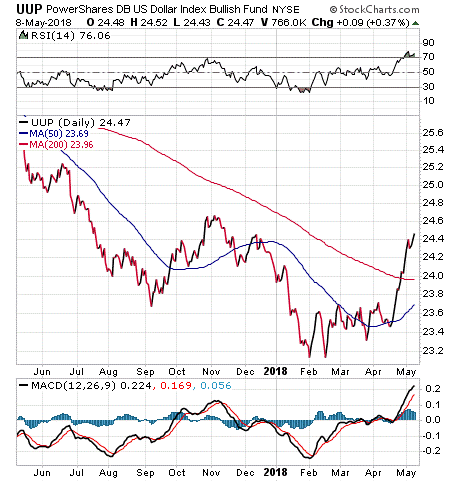The U.S. dollar has jumped compared to other currencies around the world in recent weeks and may tempt investors to buy shares in an exchange-traded fund (ETF) that tracks the greenback, writes Paul Dykewicz, editorial director of Eagle Financial Publications.
The PowerShares DB US Dollar Index Bullish Fund (UUP) is an ETF that allows investors to gain exposure to the U.S. dollar without engaging directly in foreign exchange accounts. A key question is whether the recent rise in the value of the U.S. dollar is sustainable as a long-term trend or if it is a short-term opportunity that may be best suited for traders seeking to seize quick profits.
An improving U.S. economy that started last year, compared to recent slowing of foreign economies, adds further lift to the dollar. The dollar also climbed when the U.S. unemployment rate fell to a nearly 18-year low during April, as U.S. job growth totaled 164,000 new positions and the unemployment rate slid to 3.9 percent for the first time since December 2000.
In comparison, the U.S. unemployment rate dipped from 4.1 percent, where it had leveled off for the previous six months. Although U.S. economic growth eased slightly to 2.3 percent in the first quarter of 2018, it held up reasonably well amid talk of imposing trade tariffs by President Trump and foreign leaders. Forecasters expect annualized U.S. economic growth to approach 3 percent for the rest of 2018, up slightly from the 2.9 percent annualized rise in the fourth quarter of 2017.
Investors who are concerned about volatility in the stock market but want to profit from the current outlook may see merit in the PowerShares DB US Dollar Index Bullish Fund. The ETF seeks to track changes in the level of the Deutsche Bank Long USD Currency Portfolio Index — Excess Return, plus interest income from the fund’s holdings of U.S. Treasury securities and money market incomes, minus expenses.
The fund measures the dollar’s strength against six other currencies: the European Union’s euro, the Japanese yen, the British pound, the Canadian dollar, the Swedish krona and the Swiss franc. The dollar has been rising against the euro in recent weeks.

One of Wall Street’s most ardent U.S. dollar bulls is David Woo, head of global interest rates and currencies research at Bank of America. Even more significant than the dollar’s recent rally is that interest-rate-insensitive foreign exchange flows are slowing or even ending, he said.
Woo specifically favors selling the euro and buying the U.S. dollar. As a self-described “unabashed” U.S. dollar bull, Woo listed the following eight reasons for his view:
--Continued soft euro zone economic data in April supports a theory that the “euro is too strong,” not that the euro’s weakening is due to weather;
--An upturn in U.S. business investment is paving the way for heightened productivity and wage growth;
--Progress in negotiations to revamp the North American Free Trade Agreement (NAFTA) should increase U.S. leverage in its trade talks with China;
--Corporate America may use the first-quarter earnings season to repatriate offshore cash;
--China’s deleveraging will limit the ability of the People’s Bank of China (PBOC) to match further Fed rate hikes;
--The flatness (steepness) of the U.S. (euro zone) yield curve means foreign investors only will consider currency unhedged (hedged) investment in U.S. (euro zone) bonds;
--The fiscal risk premium in the U.S. dollar already is very high; and
--Divergence between momentum and positioning are turning the tables on overextended “long” investments in the euro.
Rich Checkan, president and chief operating officer of Asset Strategies International, a full-service tangible asset dealer in Rockville, Maryland, said the dollar is showing near-term strength, even if the long-term outlook is not as rosy.
“We continue to believe the U.S. dollar has entered into a longer-term bear trend,” Checkan said. “The greenback was down 13 percent last year and is down roughly 1 percent this year… although it has recently rallied… But, considering we believe we are in a longer-term bear trend, this is strength we would consider using to your advantage while it lasts…”
The U.S. dollar index trended up a bit after President Trump announced on Tuesday afternoon, May 8, that the United States would withdraw from a multilateral agreement that removed most economic sanctions on Iran, which promised to limit its nuclear program. Trump said the United States would impose new sanctions against Iran, which chose not to agree to new terms.
“I expect any reaction would be short-term and economic fundamentals would take over,” said Bob Carlson, the editor of Retirement Watch.
However, ordinary Iranians were trying to buy U.S. dollars last month when the nation’s own currency hit an all-time low amid political uncertainty in the country and its weak domestic economy. In the face of international conflict, the U.S. dollar often becomes a safe currency for people to buy.
Jim Woods, who writes the Successful Investing and Intelligence Report advisory services, monitors the currency funds and provides his subscribers with weekly updates and a recommended exit price for each position. Woods is not a current buyer of the U.S. dollar but he confirmed he is tracking it.
Currency investments are a zero-sum game in which one form of money rises at the expense of another. For investors who believe in the Wall Street adage of “sell in May and go away,” an investment in a U.S. dollar fund could offer a reasonable way to try to profit from the currency’s uptrend and sidestep a possible summertime slippage in stocks.
Paul Dykewicz, is editorial director of Eagle Financial Publications.





















